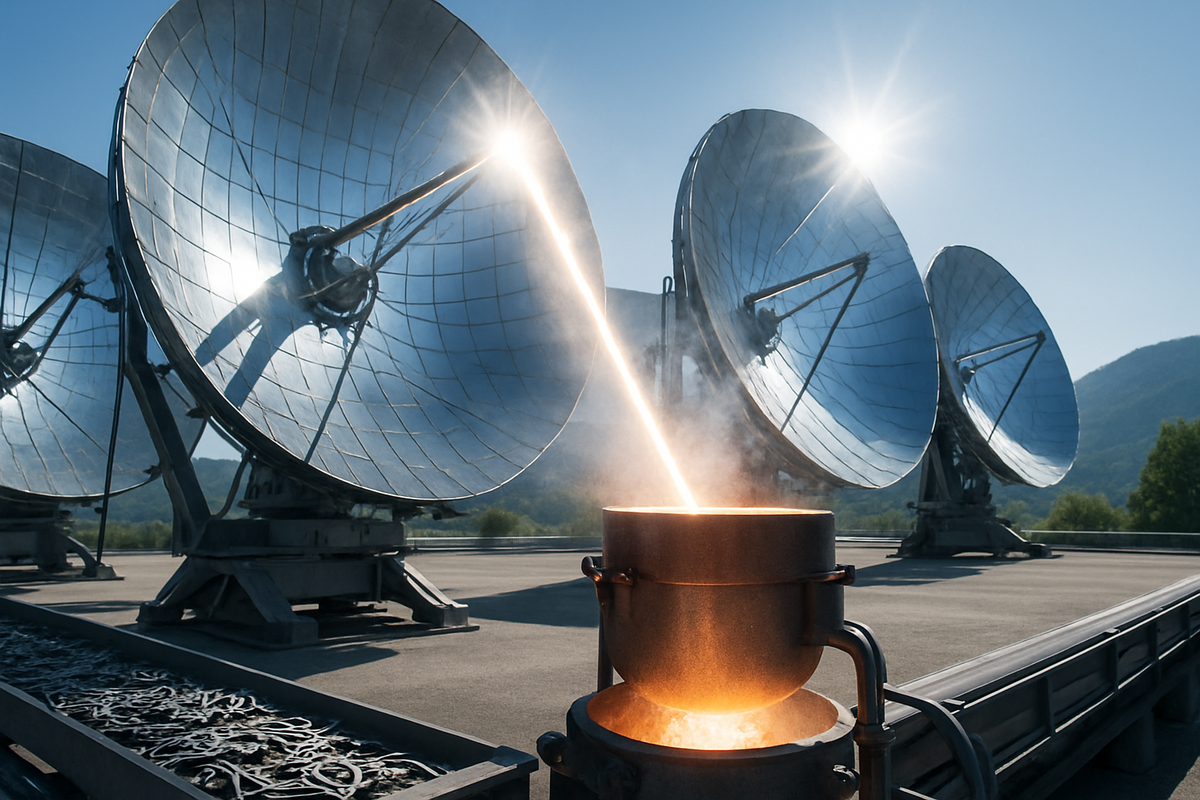
In a groundbreaking leap towards sustainable manufacturing, Swiss firm Panatere has officially launched the world's first industrial solar furnaces designed to recycle steel offcuts from the prestigious watchmaking industry. Unveiled on October 3, 2025, in La Chaux-de-Fonds, a heartland of Swiss horology, this innovation harnesses concentrated sunlight to create "green steel" with a virtually zero-carbon footprint. The immediate implications are profound, setting a new benchmark for circular economy practices within high-value manufacturing sectors and offering a tangible pathway to decarbonize one of the most energy-intensive industrial processes.
This pioneering initiative establishes a crucial local circular economy, transforming valuable production waste into high-quality ingots that can be recirculated directly to Swiss watchmakers and medical instrument manufacturers. This not only significantly reduces CO2 emissions associated with traditional steel production but also strengthens local supply chains, reduces reliance on international imports, and positions Switzerland at the forefront of eco-conscious industrial innovation.
Pioneering Green Steel: A New Dawn for Swiss Watchmaking and Beyond
The inauguration of Panatere's two industrial solar furnaces in La Chaux-de-Fonds, Canton Neuchâtel, on Friday, October 3, 2025, marks a pivotal moment for the watchmaking, medical, and aeronautical sectors. Panatere, a Swiss SME based in Saignelégier, has successfully engineered furnaces that utilize 500 concave mirrors and a heliostat to precisely focus the sun's rays onto a crucible. This system allows the furnaces to reach extreme temperatures of up to 2,000°C, efficiently melting steel, stainless steel, and titanium in approximately 1.5 hours without producing any CO2 emissions. The technology, including the alloy sorting process and the solar furnace design, is protected by two patents.
Panatere's journey to this significant launch has been a decade-long commitment to circular sustainability. Established in 2012, the company's vision for solar-powered recycling was conceived around 2015 by CEO Raphaël Broye. Key milestones include successfully melting the first ingot using solar energy at an industrial solar furnace in Odeillo, France, in December 2021, and announcing initial "solar" steel production in Switzerland in May 2021. By December 2022, Panatere unveiled plans for the world's first industrial solar furnace, with a pilot model described as 15 meters wide and 6 meters high, aiming to process 50 tons of steel and titanium from 2023. The culmination of these efforts is the October 2025 inauguration, with ambitions to scale annual production to 1,000 tonnes of solar steel by 2028 from a larger factory.
The project's success is a testament to collaborative efforts. Panatere, under the leadership of Raphaël Broye, has been the driving force. Key beneficiaries and partners include numerous Swiss watchmaking companies and medical subcontractors in the Jura arc, who provide the steel offcuts. Institutional support has been crucial, involving the École polytechnique fédérale de Lausanne (EPFL), which collaborated on the design, the Federal Office for the Environment, the Cantons of Neuchâtel, Jura, and Bern, as well as financial partners like SIG (Services Industriels de Genève), the Swiss Climate Foundation, Energy Lab, the Confédération Suisse, and Interreg France Suisse. A team of 148 scientists and professionals contributed to the initial prototype.
Initial reactions have been overwhelmingly positive, hailing the launch as a "world first" and a groundbreaking step towards "true circular sustainability." The drastically reduced carbon footprint—165 times lower than conventional methods—and the economic viability of local recycling, even with Swiss labor costs, have been particularly emphasized. The first bar of solar steel will be exhibited at the International Watch Museum in La Chaux-de-Fonds, symbolizing the blend of tradition and sustainable innovation.
Market Shapers: Who Wins and Who Loses in the Green Steel Revolution
Panatere's launch of industrial solar furnaces for green steel production is poised to reshape competitive landscapes across the watchmaking, medical instrument, and steel industries, creating distinct winners and losers.
Swiss Luxury Watchmakers are among the clearest beneficiaries. Companies like Rolex (private), Omega (SWX: UHR) (part of Swatch Group), Panerai (private) (part of Richemont), IWC (SWX: UHR), Chopard (private), Oris (private), and ID Genève (private) stand to gain significantly. By incorporating Panatere's locally sourced, ultra-low carbon "solar steel," these brands can enhance their sustainability credentials, meet the growing demand from environmentally conscious consumers, particularly Gen Z and millennials, and differentiate themselves in a highly competitive luxury market. This move strengthens their brand image and aligns with future carbon regulations, potentially offsetting any initial premium costs for green steel.
Similarly, Swiss Medical Instrument Manufacturers, especially those in the Jura region, will find a competitive edge. Access to locally recycled, ultra-low carbon stainless steel for surgical instruments and implants allows them to align with increasing sustainability mandates in healthcare and improve their product life cycle assessments. This can lead to an improved reputation among healthcare providers and potentially secure more contracts where sustainability is a key criterion.
In the broader Steel Industry, Panatere itself emerges as a significant winner, establishing a first-mover advantage in solar-powered green steel recycling. Its innovative, decentralized model could inspire similar ventures globally for specialized applications, commanding premium prices for its uniquely sustainable product. Larger international steel companies already investing in green technologies, such as H2 Green Steel (private), Swiss Steel Group (SWX: STLN), ArcelorMittal (AMS: MT), and Tata Steel (NSE: TATASTEEL), will also benefit from the broader validation and market acceptance of green steel, even if Panatere's initial volumes are small.
Conversely, Watchmakers and Medical Instrument Manufacturers (both Swiss and international) that are slow to adopt sustainable materials risk becoming losers. Their reliance on conventional steel without robust sustainability programs could lead to a perception of being environmentally irresponsible, eroding brand equity and potentially losing market share to greener competitors. They may face pressure from retailers, stricter regulations, and discerning consumers, necessitating costly overhauls to catch up.
Traditional Steel Producers, particularly those heavily reliant on Blast Furnace-Basic Oxygen Furnace (BF-BOF) methods without clear decarbonization plans, face significant challenges. They risk losing market share in high-value segments as manufacturers pivot to green alternatives. Their brand image could suffer, and they will likely face increasing financial headwinds from carbon pricing mechanisms, such as the EU ETS and Carbon Border Adjustment Mechanism (CBAM), which will raise costs for carbon-intensive imports. To remain competitive, these companies may incur substantial capital expenditures to retrofit facilities or switch to greener technologies.
A Paradigm Shift: Wider Implications for Industry and Sustainability
Panatere's solar furnace launch is more than just a technological advancement; it represents a paradigm shift with profound implications for industry and sustainability, aligning perfectly with several critical global trends.
Firstly, this initiative is a powerful embodiment of the circular economy in action. By collecting steel and titanium waste from local watchmaking, medical, and aeronautical industries and transforming it back into high-quality ingots using solar power, Panatere creates a closed-loop system. This minimizes waste, maximizes resource utilization, and fosters local material loops, directly addressing the Swiss watchmaking industry's increasing commitment to circularity, as seen in brands like Panerai (private) and ID Genève (private).
Secondly, it offers a tangible solution for decarbonization in one of the world's most carbon-intensive sectors. Steel production accounts for a significant portion of global greenhouse gas emissions. Panatere's "green steel" process, which achieves a 165-fold reduction in carbon footprint compared to conventional methods, demonstrates that industrial-scale metal melting can be achieved with virtually zero CO2 emissions by replacing fossil fuels and electricity with renewable solar energy. This breakthrough is critical for meeting ambitious climate targets.
Thirdly, the project strengthens localized supply chains and enhances resource sovereignty. By producing traceable, recyclable steel within Switzerland from local scrap, Panatere reduces dependence on volatile international markets and addresses challenges in sourcing quality steel. This trend towards reshoring and nearshoring is gaining momentum across sectors, driven by global supply chain disruptions and the desire for greater resilience and control over quality, particularly in high-precision industries like medtech and watchmaking.
The ripple effects extend across various industries. Watchmakers gain a significant advantage in meeting consumer demand for eco-conscious products and reducing their Scope 3 emissions. Medical device manufacturers can improve their product life cycle assessments, aligning with growing sustainability mandates in healthcare. While Panatere's initial output is modest, its success validates the concept of industrial-scale solar metallurgy for high-value alloys, potentially inspiring larger steel producers to invest in similar renewable energy-based melting technologies globally.
This launch also occurs amidst a tightening regulatory landscape. In Switzerland, companies face increasing pressure to align with EU standards like the Corporate Sustainability Reporting Directive (CSRD) and develop net-zero roadmaps. Panatere's operations directly support these national objectives. For Swiss companies exporting to the EU, compliance with the Ecodesign Regulation and preparation for the Carbon Border Adjustment Mechanism (CBAM) are crucial. Panatere's 100% recycled, CO2-free steel offers a significant advantage in meeting these strict environmental performance standards and navigating upcoming carbon tariffs.
Historically, while solar furnaces have been used for scientific research, Panatere's innovation stands out as the first industrial application for recycling metal waste. This distinction elevates it beyond an incremental improvement to a true breakthrough in sustainable manufacturing. It echoes the pioneering spirit of companies integrating recycled materials but goes further by creating the green material itself. This marks a critical step towards establishing truly green metallurgy as a viable industrial process.
The Road Ahead: What's Next for Solar Steel and Sustainable Manufacturing
Panatere's solar furnace technology is on the cusp of significant expansion and evolution, poised to shape the future of green steel and sustainable manufacturing. In the short term, by 2028, Panatere aims to scale its annual production to 1,000 tonnes of solar steel. This involves continuous optimization of its patented solar furnace systems for greater efficiency and reliability, potentially integrating energy storage solutions to address solar intermittency. The immediate focus remains on high-value industries like watchmaking and medical device manufacturing in the Jura region, leveraging the localized, circular economy model to recycle valuable metal waste.
Looking further ahead, Panatere envisions establishing a "Solar Treatment Center for Strategic Metals" (CTSM), signifying a long-term expansion beyond steel to include other high-value strategic metals. The company's aspiration to make its industrial solar furnace a "public commodity" suggests a vision for wider adoption, potentially through licensing its patented technology or forming joint ventures in other sun-rich regions globally. Such a decentralized model could foster local green steel production and significantly reduce global carbon footprints.
Strategic pivots for Panatere will likely include geographic expansion, diversifying the types of recycled materials, and forging enhanced partnerships with larger industrial players. Achieving cost competitiveness independent of initial subsidies will be crucial as the technology matures, though rising metal prices and demand for sustainable products may naturally support this. Optimizing local supply chains for waste collection and ingot distribution will further reinforce the circular economy.
New market opportunities are emerging in high-value industrial sectors demanding premium, traceable, and sustainably sourced materials. The drive for decentralized production and resource sovereignty, coupled with a growing "green premium" demand, presents significant avenues for growth. Favorable regulatory landscapes, such as the EU's CBAM, will also boost demand for low-carbon products. However, challenges remain, including the substantial capital investment required for scaling, overcoming the intermittency of solar energy, and navigating competition from other green steel technologies like hydrogen-based direct reduction. Ensuring a consistent supply of quality scrap metal and establishing consistent standardization and certification for green steel are also critical.
The global green steel market is projected for explosive growth, with some estimates suggesting a market size of USD 624.414 billion by 2032. Panatere's solar-powered recycling could lead to several outcomes: it might solidify its position as a niche leader in high-value circular economy products, inspire the proliferation of decentralized green steel hubs globally, or become an integral component within broader integrated hybrid green steel solutions. Ultimately, its success will depend on its ability to scale, adapt to market dynamics, and overcome the challenges inherent in pioneering a truly disruptive technology.
Investing in a Greener Future: Key Takeaways and Outlook
Panatere's launch of industrial solar furnaces for green steel production is a watershed moment for sustainable manufacturing, offering profound implications for investors. The key takeaway is the proven commercial viability of using concentrated solar power for industrial-scale metal recycling, demonstrating a tangible pathway to near-zero CO2 emissions in steel production. This localized, circular economy model not only reduces environmental impact by a factor of 165 compared to conventional methods but also enhances supply chain resilience and resource sovereignty for high-value industries like watchmaking and medical instruments.
The market for green steel and sustainable manufacturing is on an accelerating growth trajectory, projected to reach hundreds of billions of dollars within the next decade. This expansion is fueled by stringent decarbonization targets, evolving regulations, and surging consumer and corporate demand for eco-friendly products. Panatere's innovation positions it at the forefront of this transformation, offering a unique, patented solution that aligns perfectly with these powerful macroeconomic and environmental forces.
The lasting impact of this event lies in its potential to serve as a blueprint for other heavy industries seeking to decarbonize. It validates the idea that competitive, sustainable, and local industrial production without CO2 emissions is not merely an aspiration but an achievable economic reality. This could accelerate the adoption of similar renewable energy-based technologies worldwide, contributing significantly to global climate goals.
Investors should closely monitor several key indicators in the coming months. Firstly, observe Panatere's operational scale-up, particularly its progress towards the 2028 production target of 1,000 tons of solar steel. Successful scaling will be crucial for validating the technology's long-term economic potential. Secondly, look for signs of replication or partnerships, as broader adoption of Panatere's technology or similar concentrated solar power solutions will signal wider market acceptance. Thirdly, track green steel market premiums and demand from major end-use industries, as sustained willingness to pay a premium will underpin market expansion. Fourthly, stay informed about policy and regulatory developments, such as new government incentives or the impact of the EU's CBAM, which will further accelerate the transition to green steel. Finally, keep an eye on advancements in green hydrogen and other decarbonization technologies, as well as cost reduction innovations and the integration of AI in manufacturing, all of which will shape the broader competitive landscape of green steel.
Panatere's achievement provides a compelling example of how innovation can drive industrial decarbonization. Investors who closely follow these developments will be well-positioned to identify early opportunities in this rapidly evolving and increasingly critical sector.
This content is intended for informational purposes only and is not financial advice.






